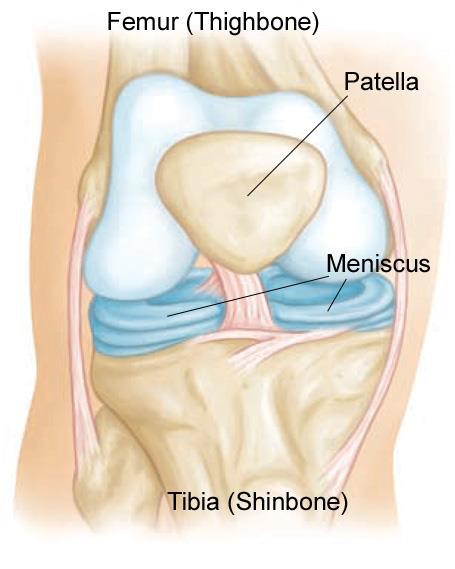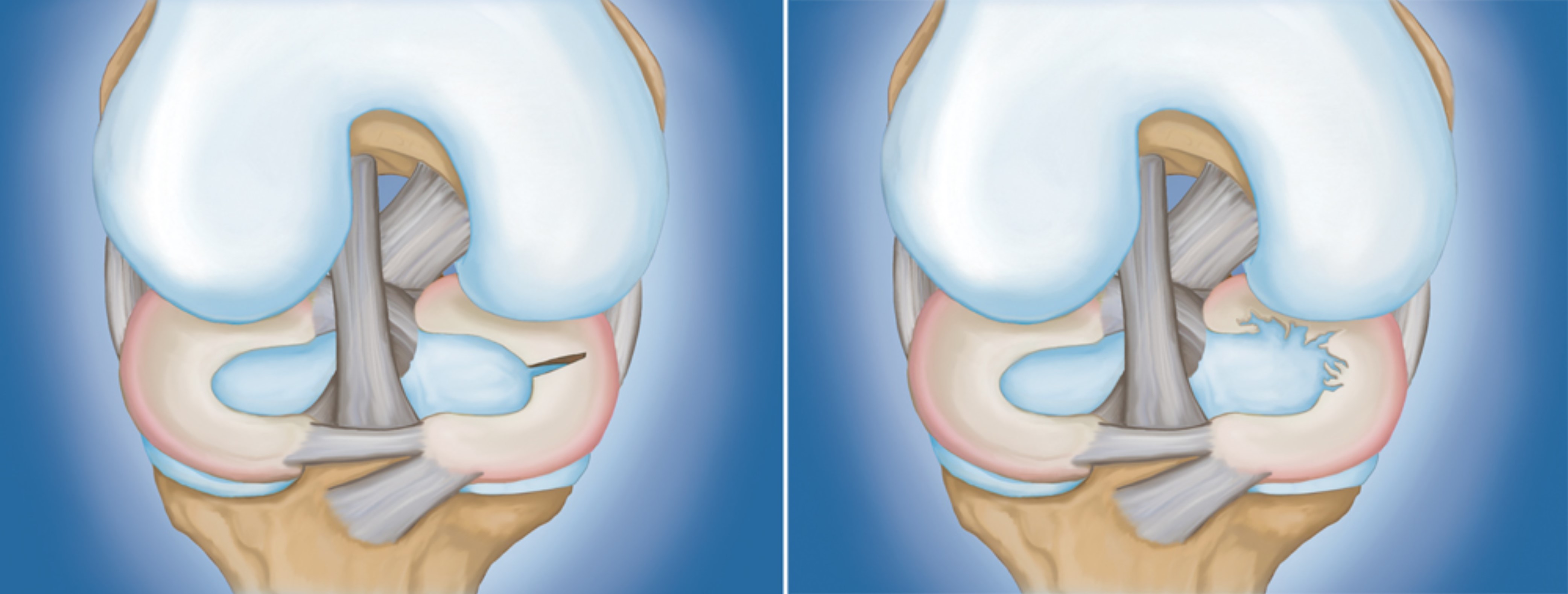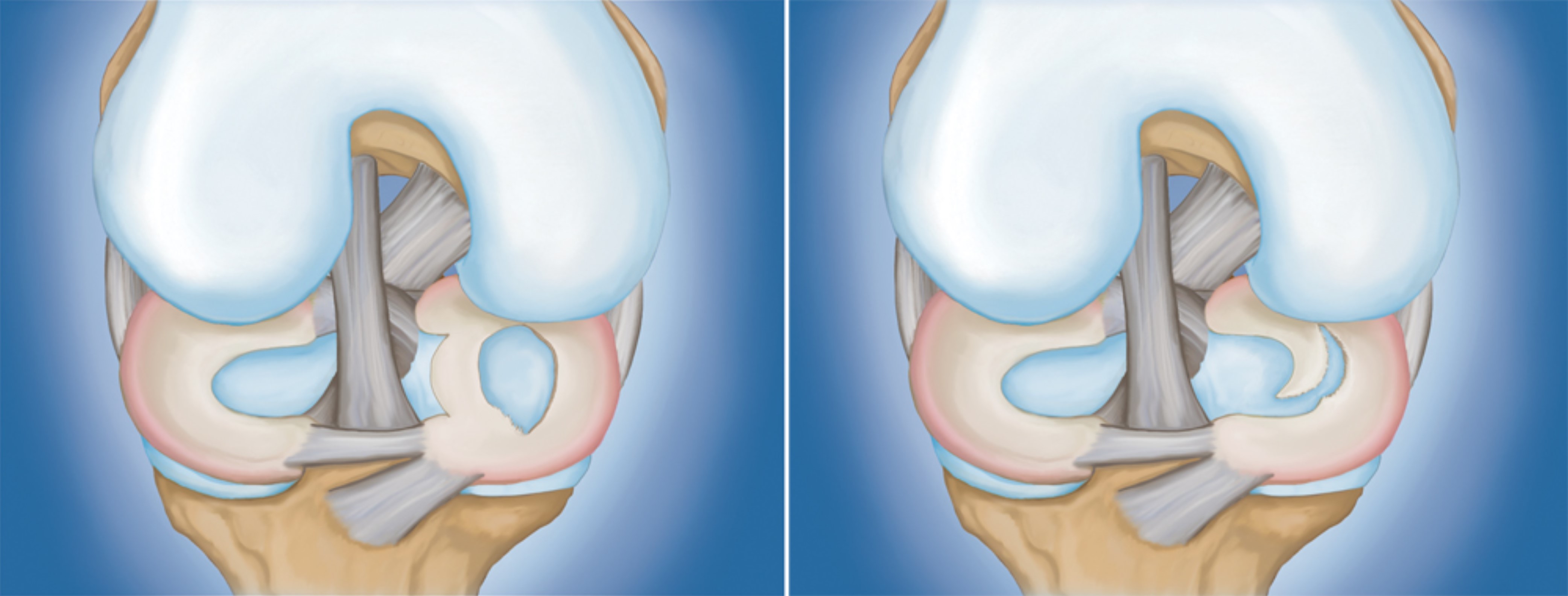A meniscal tear is a tear that occurs in the cartilage of the knee. The meniscus is a small, "C" shaped piece of cartilage in the knee joint. Each knee has two menisci, the medial meniscus on the inner aspect of the knee and the lateral meniscus on the outer aspect of the knee. The medial and lateral menisci act as a cushion between the thigh bone (femur) and shin bone (tibia), and increase the conformity of the knee.
Meniscus tears are among the most common knee injuries. Athletes, particularly those who play contact sports, are at risk for meniscus tears. However, anyone at any age can tear a meniscus. When people talk about torn cartilage in the knee, they are usually referring to a torn meniscus.

orthoinfo.aaos.org
Normal anatomy of the knee. The menisci are two rubbery C-shaped discs that help cushion the knee joint.
Types of Meniscal Tear
Meniscal tears are described according to the location and extent of the tear, and include:
- Frayed edge - In this type, the inner rim of the meniscus has a ragged appearance, and is commonly seen with degenerative disease in the knee.
- Radial tear - This type of tear occurs as a sharp split which starts along the inner edge of the meniscus extending towards the lateral rim.

orthoinfo.aaos.org
(Left) Radial tear. (Right) Degenerative (frayed edge) tear
- Parrot-beak tear: This is an oblique tear of the inner rim of the meniscus that appears curved like a parrot's beak.
- Circumferential tear (Longitudinal tear): This is a tear that occurs along the length of the meniscus.
- Bucket-handle tear: This is a tear that goes all the way through the full depth of the meniscus. The handle portion of this type of tear may displace into the middle of the knee, where it may cause locking, pain and lack of ability to fully straighten (extend) the knee.
- Horizontal cleavage tear: This type of tear starts after a minor injury as a horizontal split deep in your meniscus which is followed by degenerative changes in the area of damage. Eventually, the meniscus divides into top and bottom sections, like a “fish-mouth”.
- Flap tear: This type of tear occurs on the surface of the meniscus and creates a flap that moves.

orthoinfo.aaos.org
(Left) Bucket handle tear. (Right) Parrot-beak tear.
Sports-related meniscus tears often occur along with other knee injuries, such as anterior cruciate ligament tears.
Causes
The meniscus can tear following a twisting type of injury during sports or even when getting out of a chair or standing up from a squatting position. Athletes tear their meniscus by either a twisting or pivoting motion (particular under load), over flexing the knee joint, or sudden stopping or deceleration. Also as we age, our cartilage becomes a little more brittle and can therefore tear more easily (the meniscus has been reported to start dehydrating and undergoing age changes from as early as age 21).
Symptoms
Most people can still walk on the injured knee. The common symptoms of a meniscal tear include:
- Pain over the inner or outer side of the knee, where the tear occurred
- A "pop” or “click" may be felt at the time of injury
- Catching or locking of the knee joint may occur if the torn cartilage gets caught between the femur and tibia
- Stiffness and swelling of the knee, often develop over a few days
- Inability to move your knee through its complete range of motion
- Sensation of your knee "giving way", or feeling that the knee is unreliable
Diagnosis
A/Prof Woodgate will take a detailed history of symptoms and perform a physical examination of your knee, particularly noting any tenderness over the area of the joint line where the meniscus sits. One of the main diagnostic tests for meniscus tears is the McMurray test. A/Prof Woodgate will initially bend the knee and then straighten and rotate it. This puts tension on a torn meniscus. If you have a meniscus tear, this movement will cause a clicking sound. Your knee will click each time the test is repeated.
Xrays may be ordered to exclude osteoarthritis or other possible causes of knee pain. MRI scans may be obtained to better show the menisci, and assess for associated damage to ligaments or the joint surfaces.
Treatment
Options for managing your meniscal tear will depend on the type of tear you have, its size, and location. Your age, activity level, and any related injuries will factor into your treatment plan.
The outer one-third of the meniscus has a rich blood supply. A tear in this "red" zone may heal on its own, or can often be repaired with surgery. A longitudinal tear is an example of this kind of tear. In contrast, the inner two-thirds of the meniscus lacks a blood supply. Without nutrients from blood, tears in this "white" zone cannot heal. These complex tears are often in thin, worn cartilage. Because the pieces cannot grow back together, tears in this zone are usually surgically trimmed away.
Nonsurgical Treatment
Initial manage after injury usually involves the RICE protocol (Rest, Ice, Compression, and Elevation) to control pain and swelling. Small tears, particularly near the outer edge of the meniscus, can be treated conservatively with anti-inflammatory medications and physical therapy to strengthen muscles around the knee and prevent joint instability. A knee brace may be needed in the short term to immobilize your knee. You may need to walk with crutches temporarily to assist in limiting weight bearing.
Surgical Treatment
If your symptoms persist despite nonsurgical treatment, arthroscopic knee surgery may be suggested. Knee arthroscopy is one of the most commonly performed surgical procedures. In it, a miniature camera is inserted through a small incision (portal). This provides a clear view of the inside of the knee, and allows A/Prof Woodgate to insert miniature specific surgical instruments through other portals to trim or repair the tear.
- Meniscectomy - In this minimally invasive procedure, the torn portion of the meniscus is removed and trimmed back to a stable base.
- Meniscal Repair - Some meniscus tears can be repaired by suturing (stitching) the torn pieces together, which restores the normal anatomy of the knee. Whether a tear can be successfully treated with repair depends upon the type of tear, as well as the overall condition of the injured meniscus. Because the meniscus must heal back together, recovery time for a repair is much longer than from a meniscectomy. It is not recommended for tears in the white (avascular) zone.
Once the initial healing is complete, rehabilitation exercises will be advised. Regular exercise to restore your knee mobility and strength is necessary. You will start with exercises to improve your range of motion. Strengthening exercises will gradually be added to your rehabilitation plan.
For the most part, rehabilitation can be carried out at home, although a formal physical therapy programme is sometimes needed. Rehabilitation time for a meniscus repair is about 3 months. A meniscectomy requires less time for healing — approximately 3 to 4 weeks.
